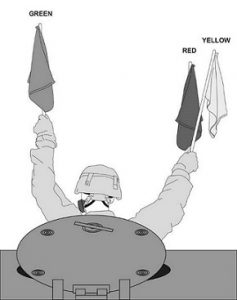Soldiers need to be able to communicate on a noisy, dangerous battlefield even when conventional means of communication are unavailable.
To help meet that need, the US Army has just updated its compilation of hand and flag signals.
One configuration of flags signifies “Chemical, biological, radiological, and nuclear hazard present”:

Or a soldier may need to signal “I do not understand,” as follows:

See Visual Signals for Armor Fighting Vehicles (Combined Arms), GTA 17-02-019, US Army, February 2018.
At a time when universities are already facing intense pressure to re-envision their role in the S&T ecosystem, we encourage NSF to ensure that the ambitious research acceleration remains compatible with their expertise.
FAS CEO Daniel Correa recently spoke with Adam Marblestone and Sam Rodriques, former FAS fellows who developed the idea for FROs and advocated for their use in a 2020 policy memo.
In a year when management issues like human capital, IT modernization, and improper payments have received greater attention from the public, examining this PMA tells us a lot about where the Administration’s policy is going to be focused through its last three years.
Congress must enact a Digital Public Infrastructure Act, a recognition that the government’s most fundamental responsibility in the digital era is to provide a solid, trustworthy foundation upon which people, businesses, and communities can build.